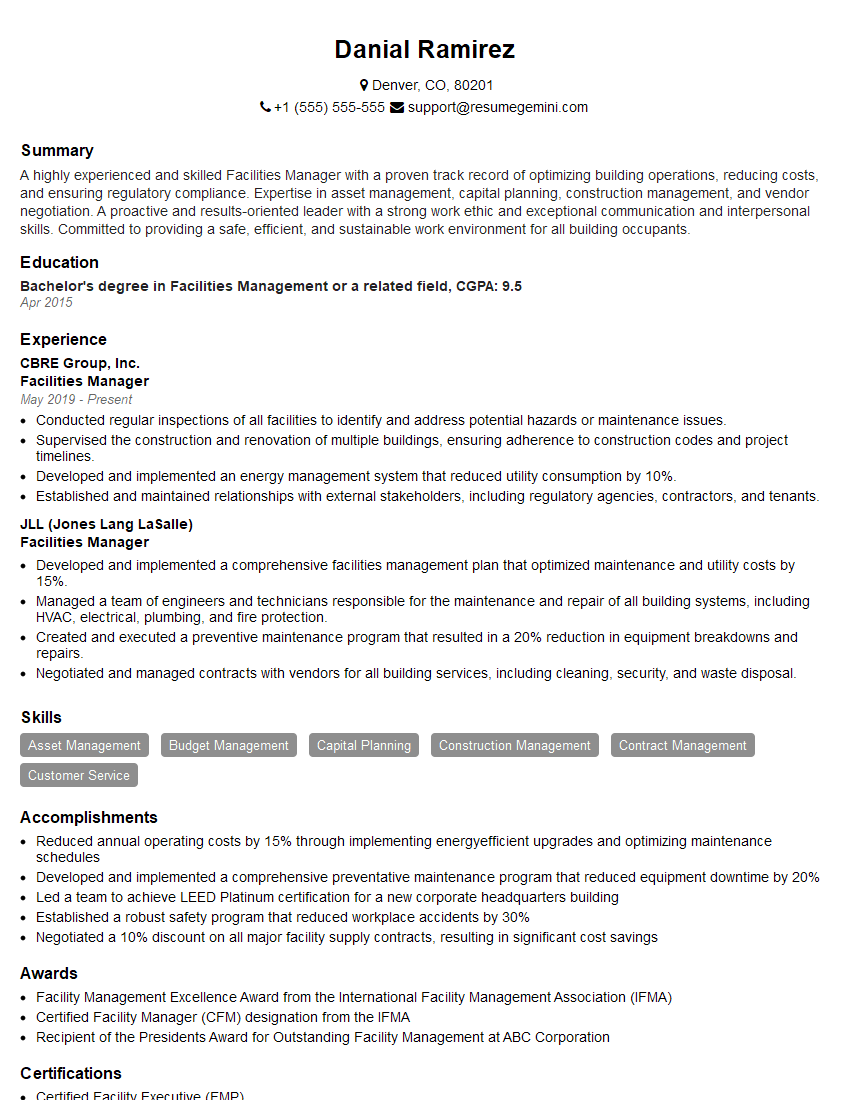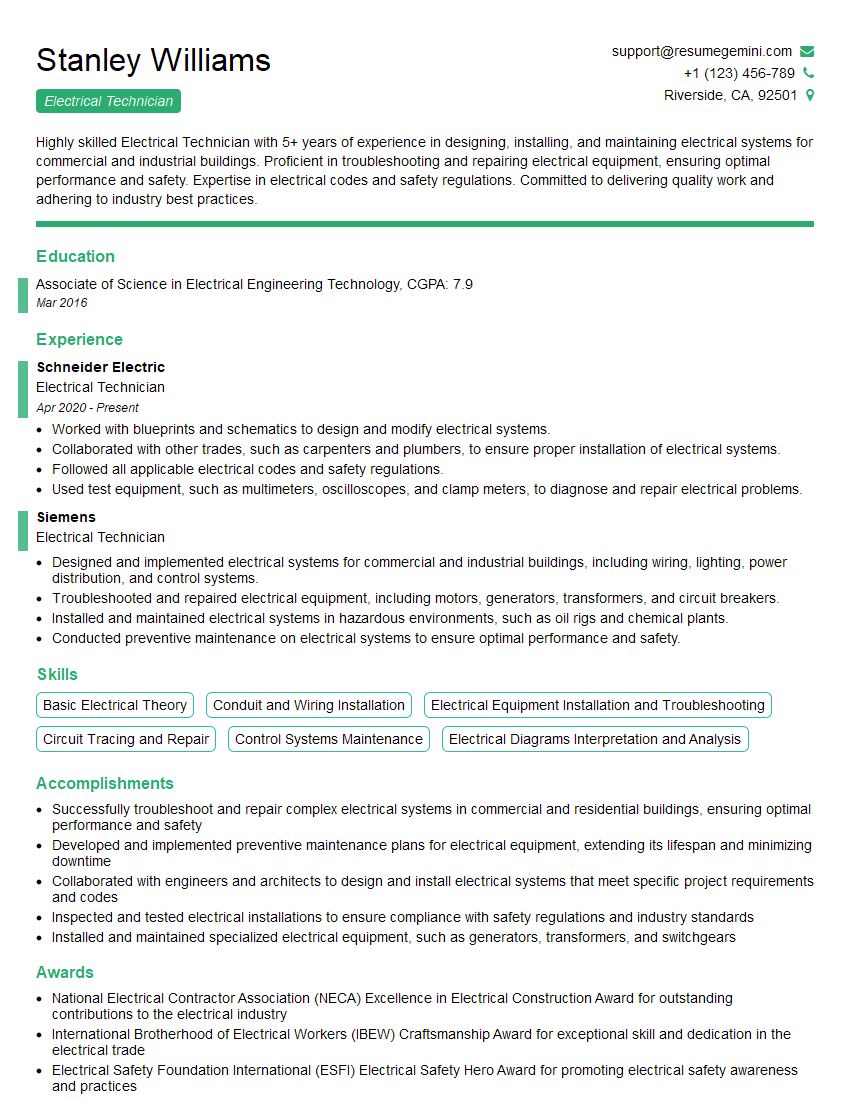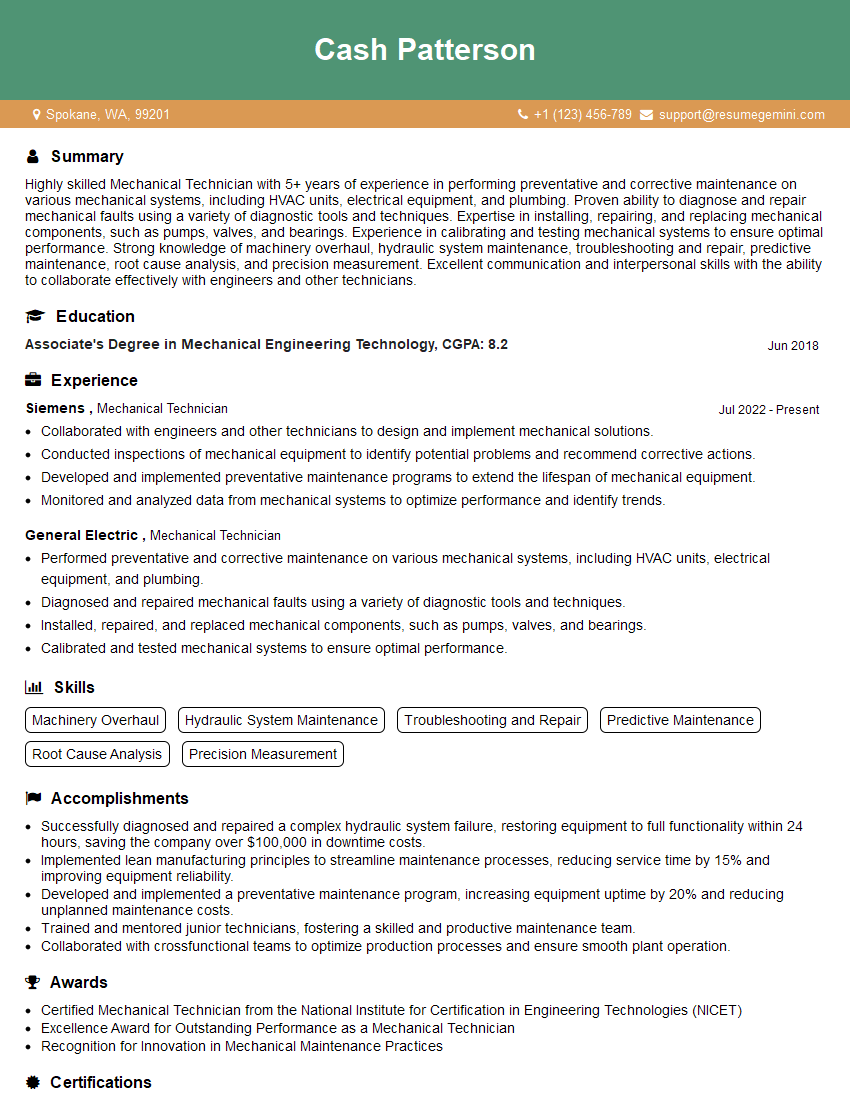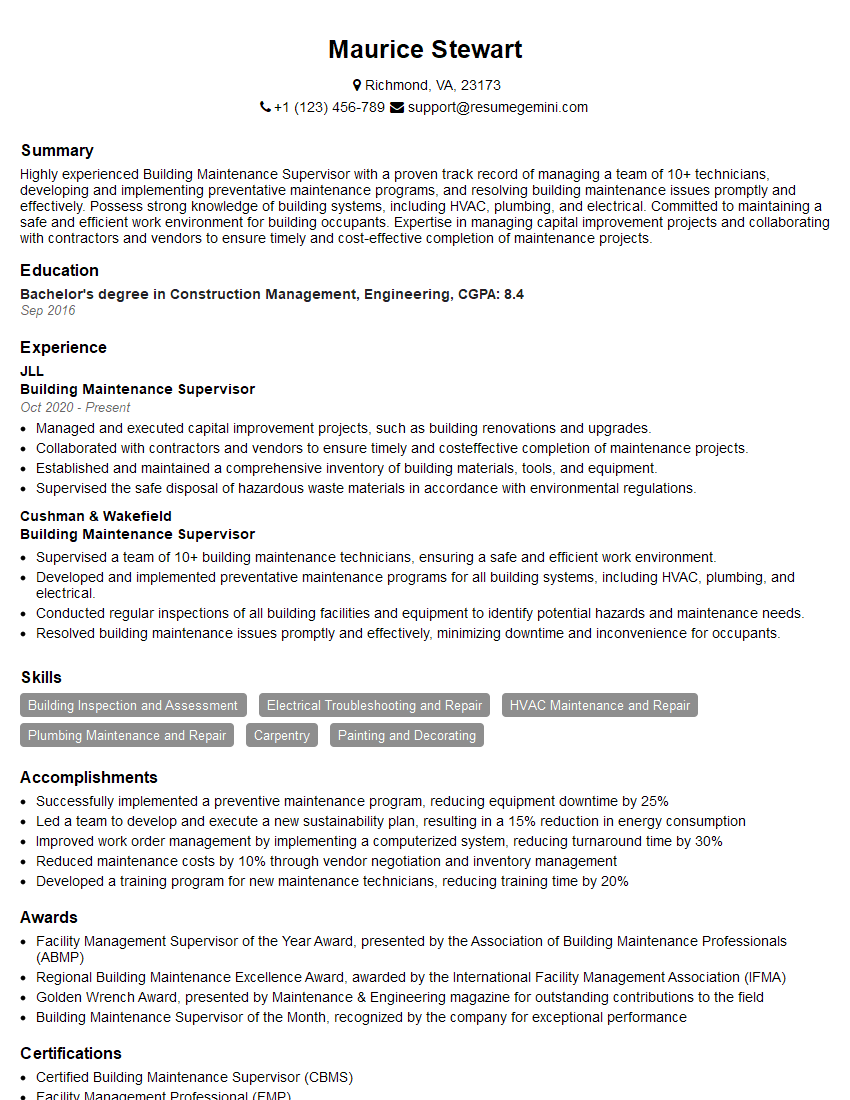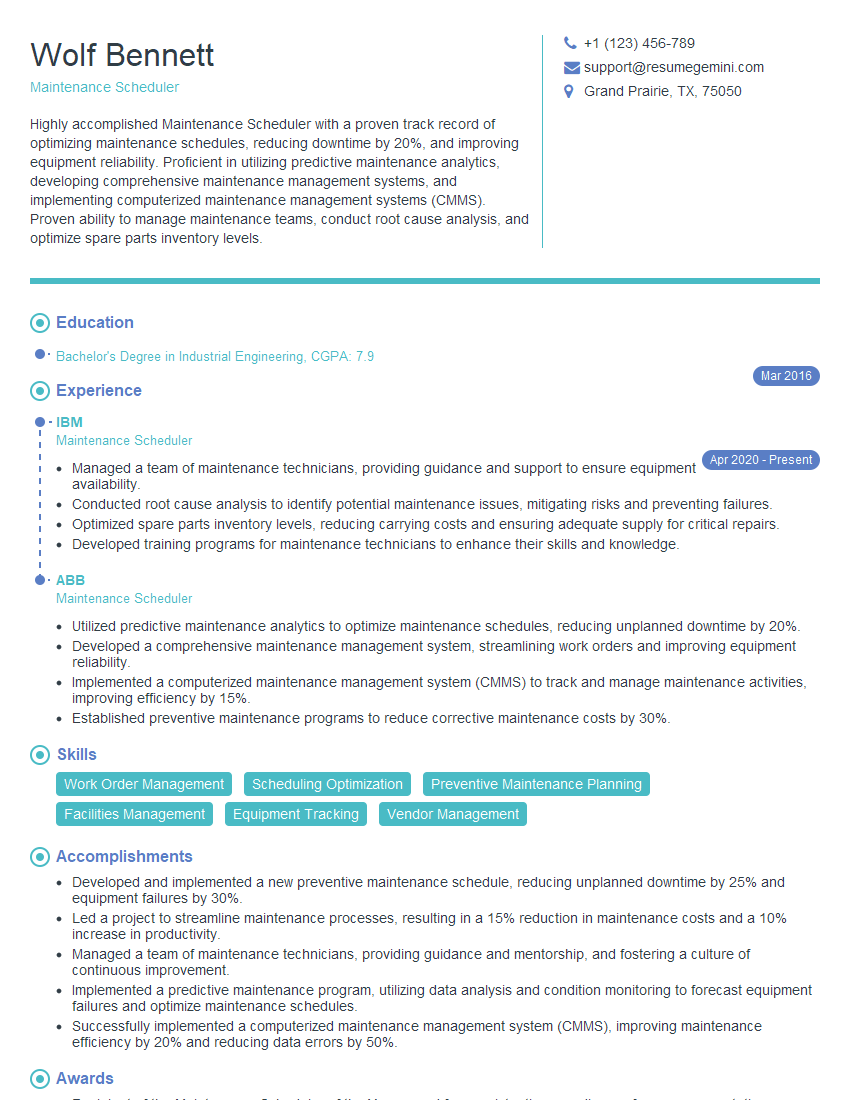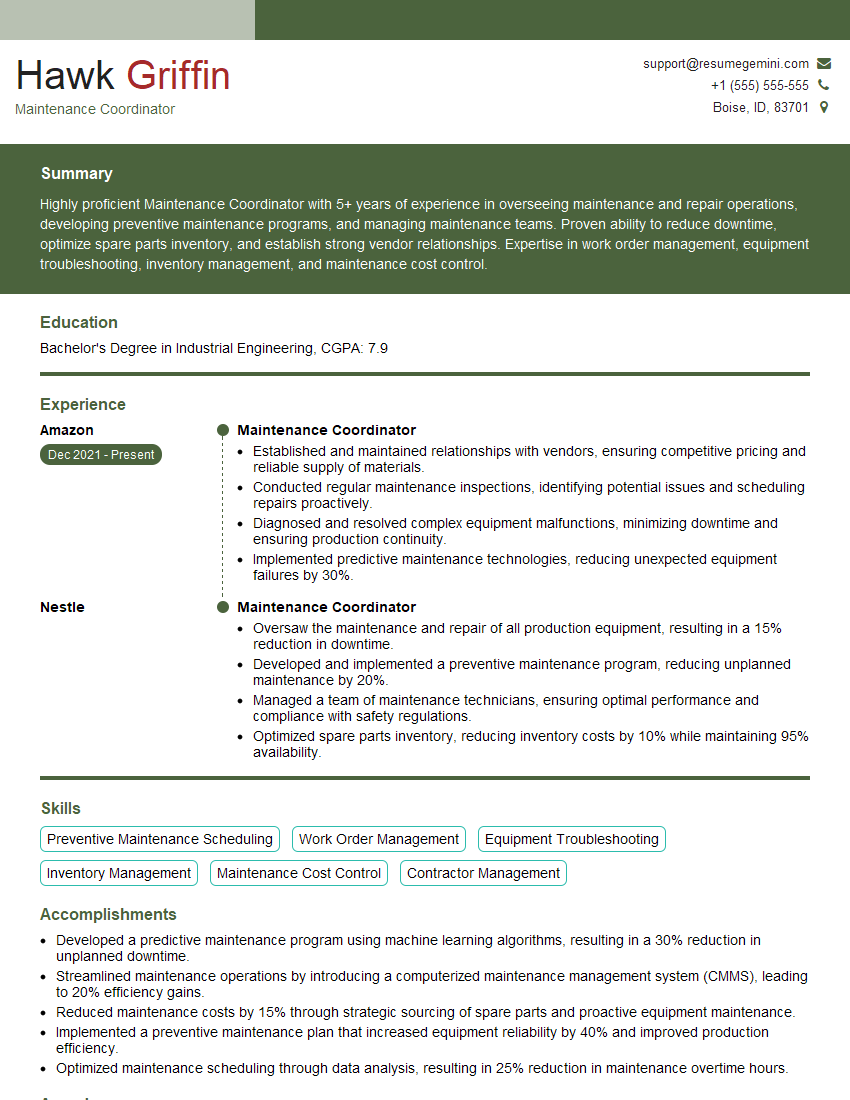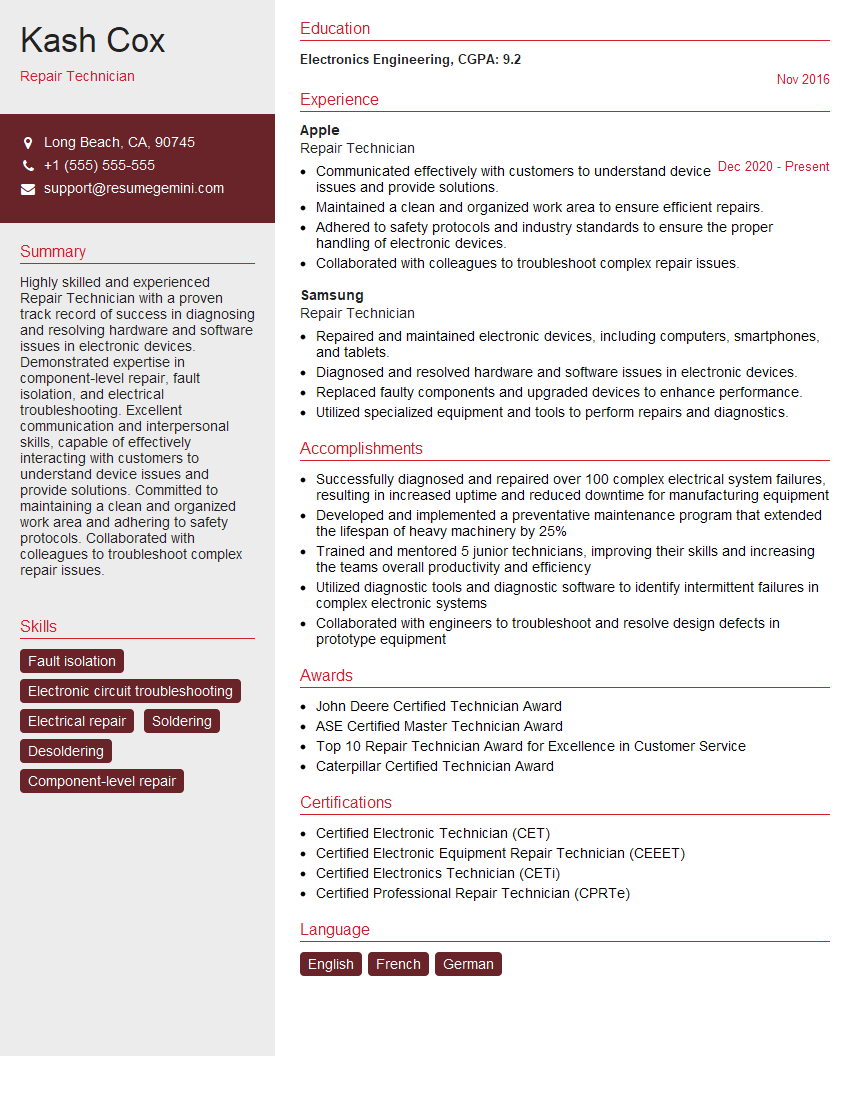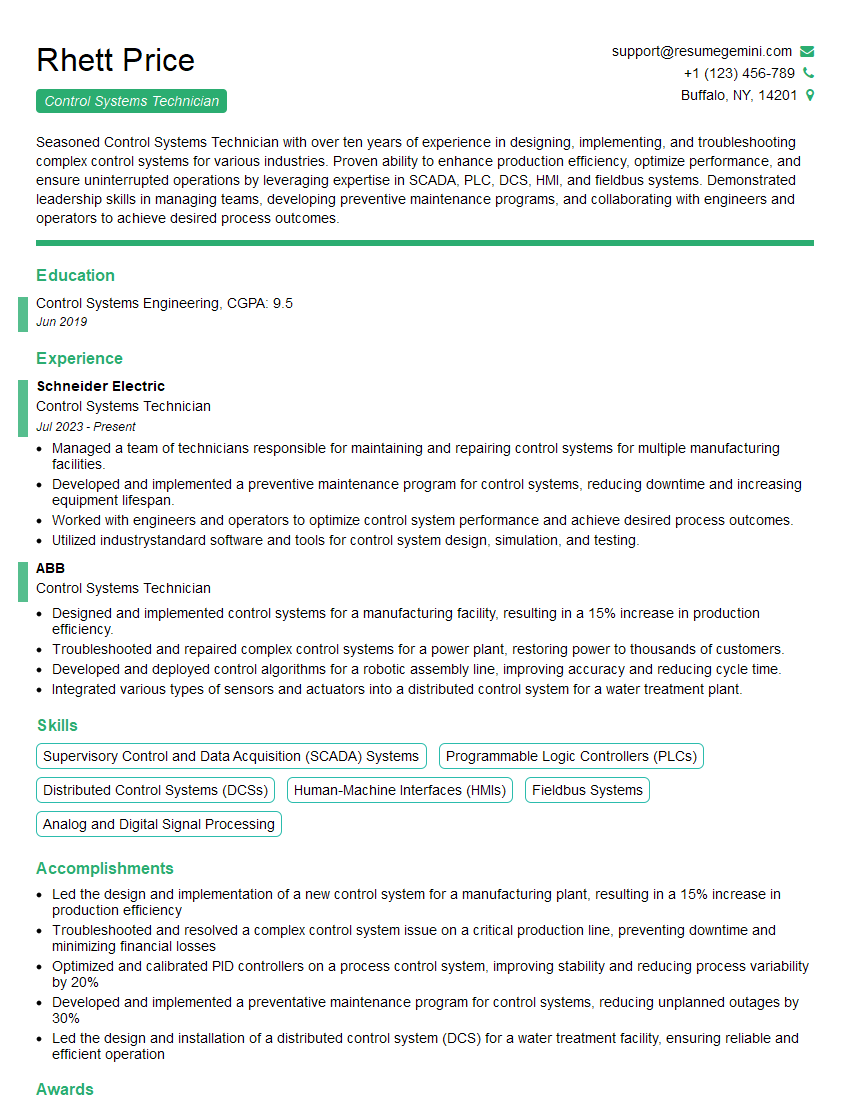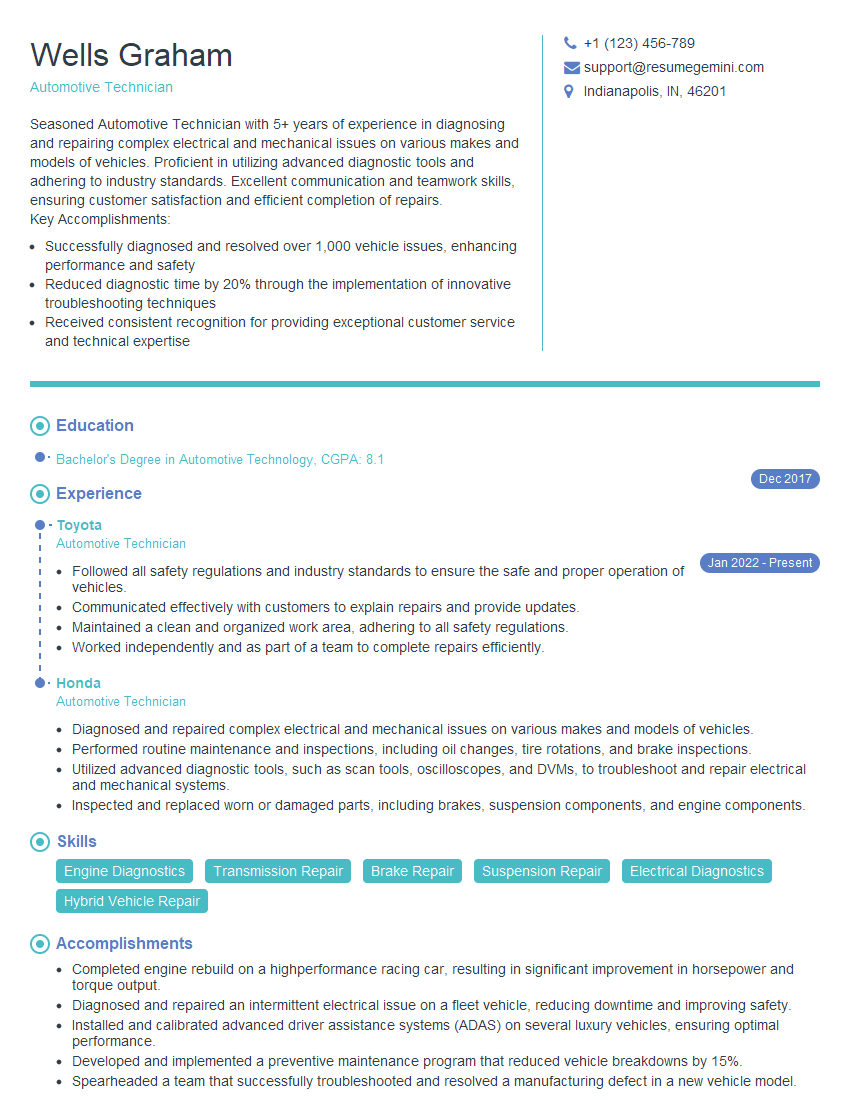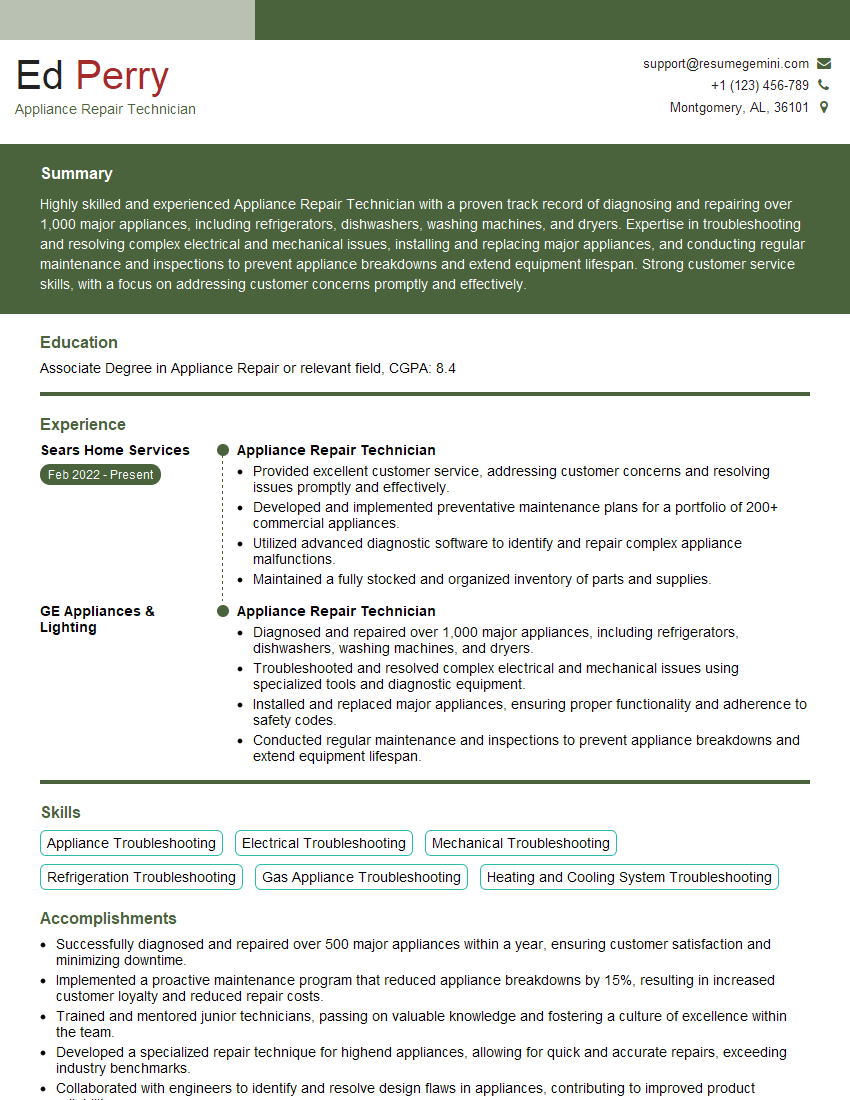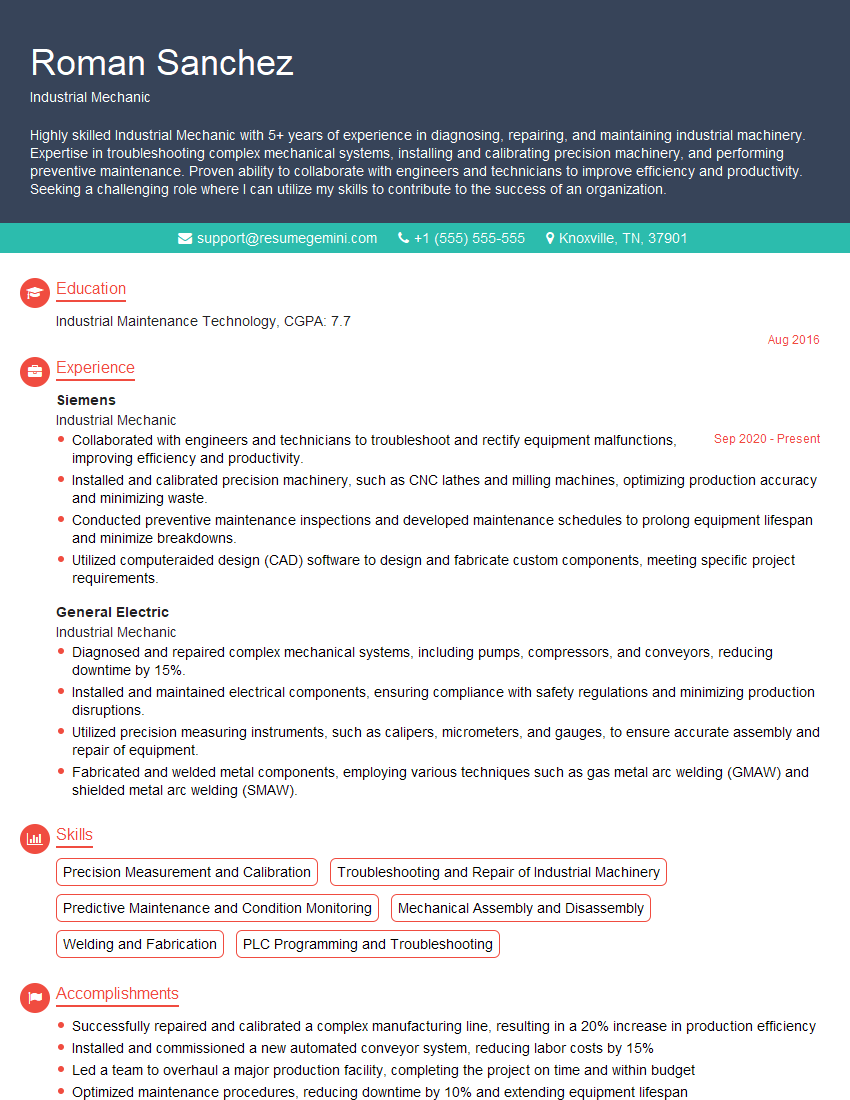Are you ready to stand out in your next interview? Understanding and preparing for Knowledge of maintenance and repair procedures interview questions is a game-changer. In this blog, we’ve compiled key questions and expert advice to help you showcase your skills with confidence and precision. Let’s get started on your journey to acing the interview.
Questions Asked in Knowledge of maintenance and repair procedures Interview
Q 1. Describe your experience with preventive maintenance.
Preventive maintenance is all about keeping equipment running smoothly by performing regular inspections and servicing before problems arise. It’s like getting your car serviced regularly – you change the oil, check the tires, and address small issues before they become major breakdowns. This significantly reduces downtime and extends the lifespan of your equipment.
In my previous role at Acme Manufacturing, I implemented a comprehensive preventive maintenance program for our assembly line. This included creating a detailed schedule for routine tasks like lubrication, cleaning, and inspections of critical components. We used a computerized maintenance management system (CMMS) to track tasks, generate alerts, and ensure nothing was overlooked. This resulted in a 25% reduction in unscheduled downtime over the course of a year.
- Example: Regularly scheduled inspections of conveyor belts for wear and tear, replacing worn sections proactively to prevent complete failure.
- Example: Implementing a lubrication schedule for all moving parts to reduce friction and prevent premature wear.
Q 2. Explain the process of troubleshooting a malfunctioning machine.
Troubleshooting a malfunctioning machine involves a systematic approach to identify the root cause of the problem. Think of it like a detective solving a case – you gather clues, analyze them, and then formulate a solution. It’s not about randomly replacing parts; it’s about using logic and observation.
- Identify the Problem: Observe the machine closely. What exactly is malfunctioning? Are there error codes? Are there any unusual sounds, smells, or vibrations?
- Gather Information: Consult manuals, schematics, and previous maintenance records. Talk to operators – they often provide valuable insights into the issue’s onset.
- Formulate a Hypothesis: Based on the gathered information, develop a theory about the cause of the malfunction. This is where your experience and knowledge of the machine’s mechanics come in.
- Test Your Hypothesis: Conduct tests to verify your theory. This might involve checking voltage, inspecting wiring, or testing individual components.
- Implement Solution: Once you’ve confirmed the cause, implement the necessary repair or replacement.
- Document Findings: Carefully document the problem, the troubleshooting steps taken, and the final solution. This is crucial for future reference and preventive maintenance planning.
Example: If a robotic arm on an assembly line stops moving, I would first check for power supply issues, then inspect the motor, wiring, and control system before considering more complex mechanical problems.
Q 3. What are your preferred methods for diagnosing equipment failures?
My preferred methods for diagnosing equipment failures combine several approaches for a comprehensive analysis:
- Visual Inspection: A thorough visual check for obvious signs of damage, wear, or leaks is always the first step. This might involve looking for loose connections, broken parts, or unusual discoloration.
- Testing with Instruments: Using multimeters, oscilloscopes, and other diagnostic tools helps pinpoint electrical or electronic faults. I’m proficient with various testing equipment and know how to interpret the readings accurately.
- Data Analysis: If the machine has sensors and data logging capabilities, analyzing the data leading up to the failure can offer valuable clues. Patterns or anomalies in performance data can point to underlying problems.
- Expert Consultation: For complex systems or unfamiliar equipment, consulting with experienced technicians or manufacturers can be invaluable.
Example: When a pump failed to deliver the expected flow rate, I used a flow meter to measure the actual flow, a pressure gauge to check the pressure, and then inspected the pump impeller for wear and tear. This systematic approach helped quickly identify a clogged impeller as the cause.
Q 4. How do you prioritize maintenance tasks in a high-pressure environment?
Prioritizing maintenance tasks in a high-pressure environment requires a structured approach. I use a combination of methods to ensure critical tasks are addressed promptly while still managing less urgent ones.
- Risk Assessment: I assess the potential impact of each task on production and safety. Tasks that pose the highest risk of downtime or safety hazards are prioritized.
- Urgency and Importance Matrix: This matrix helps categorize tasks based on urgency (how soon it needs to be done) and importance (its impact on operations). High-urgency, high-importance tasks are addressed first.
- CMMS Utilization: A CMMS allows for efficient scheduling and tracking of maintenance tasks based on predefined criteria, automatically alerting to overdue or critical issues.
- Communication and Collaboration: Open communication with production teams helps identify emerging issues and adjust priorities as needed.
Example: If a critical machine fails, all other non-critical tasks are postponed until the critical one is fixed, minimizing overall production downtime.
Q 5. Describe your experience with different types of maintenance (predictive, preventive, corrective).
My experience encompasses all three types of maintenance:
- Preventive Maintenance: As discussed earlier, this involves scheduled inspections and servicing to prevent failures. It’s proactive and cost-effective in the long run.
- Corrective Maintenance: This addresses problems after they occur. While necessary, it’s often more costly and disruptive than preventive maintenance. It involves diagnosing the problem, repairing or replacing faulty parts, and returning the equipment to service.
- Predictive Maintenance: This uses data analysis and advanced technologies like vibration analysis or thermal imaging to predict potential failures before they happen. It allows for proactive maintenance, minimizing downtime and optimizing resource allocation. I have experience using vibration sensors on rotating machinery to detect imbalances that could lead to catastrophic failure.
Example: In one instance, predictive maintenance using vibration analysis on a motor alerted us to an impending bearing failure weeks before it actually happened, allowing for a planned replacement during a scheduled downtime, preventing costly emergency repairs.
Q 6. What safety procedures do you follow during maintenance and repair work?
Safety is paramount in all maintenance and repair work. I adhere strictly to the following procedures:
- Lockout/Tagout (LOTO): Before starting any work on equipment with potential energy sources (electrical, hydraulic, pneumatic), I always follow LOTO procedures to isolate the energy source and prevent accidental startup.
- Personal Protective Equipment (PPE): I use appropriate PPE, such as safety glasses, gloves, hearing protection, and safety shoes, depending on the task.
- Risk Assessment: I conduct a thorough risk assessment before starting any job to identify potential hazards and develop a safe work plan.
- Working at Heights Safety: If working at heights is required, I utilize proper fall protection equipment and follow all safety regulations.
- Confined Space Entry: If working in confined spaces, I follow strict procedures for atmospheric monitoring, ventilation, and entry/exit procedures.
- Hazardous Material Handling: I follow proper procedures for handling hazardous materials, including using appropriate PPE and following disposal guidelines.
Example: Before working on a high-voltage electrical panel, I always lock out and tag out the power supply to prevent accidental electrocution.
Q 7. How do you document maintenance activities and repairs?
Accurate and detailed documentation is essential for effective maintenance management. My documentation practices include:
- CMMS Entries: I meticulously record all maintenance activities and repairs in our CMMS, including dates, times, tasks performed, parts replaced, and any relevant observations.
- Work Orders: For each maintenance task, I create a work order that details the problem, the actions taken, and the results.
- Photographs and Videos: I often take photographs or videos to document the condition of equipment before, during, and after repairs. This provides visual evidence and assists in future troubleshooting.
- Spare Parts Inventory: I maintain a detailed inventory of spare parts, recording their usage and ensuring adequate stock levels.
Example: After repairing a faulty pump, I would document the work order with details about the failed part, its replacement, and any specific steps taken to rectify the issue. Pictures of the old and new parts would be included to provide visual clarity.
Q 8. What software or tools do you use for maintenance management?
For maintenance management, I utilize a combination of software and tools tailored to the specific needs of the equipment and the organization. This often includes Computerized Maintenance Management Systems (CMMS). These are software applications designed to manage and track maintenance activities, including scheduling preventative maintenance, tracking work orders, managing inventory, and generating reports. Popular examples include Fiix, UpKeep, and IBM Maximo.
Beyond CMMS, I also rely on specialized software depending on the equipment. For example, if we’re dealing with complex PLC-controlled machinery, I might use programming software specific to the PLC brand (like Rockwell Automation’s RSLogix 5000 or Siemens TIA Portal) to diagnose and program the control systems. Additionally, I use diagnostic tools specific to the equipment, such as handheld analyzers for vibration analysis, thermal imaging cameras for detecting overheating components, and multimeters for electrical testing.
Finally, effective maintenance management also involves utilizing tools for data analysis. This could be as simple as spreadsheets for tracking key performance indicators (KPIs), or more sophisticated business intelligence tools to visualize maintenance trends and optimize maintenance strategies.
Q 9. Describe a time you had to troubleshoot a complex equipment problem.
During my time at a manufacturing plant, a critical conveyor system malfunctioned, causing a significant production slowdown. The problem was intermittent and difficult to pinpoint. It would stop unexpectedly, throwing error codes that weren’t readily explained in the system’s documentation.
My troubleshooting process started with systematically checking the obvious: power supply, motor operation, and sensor readings. However, these initial checks revealed nothing conclusive. I then moved to a more in-depth analysis. Using a logic analyzer, I examined the signals being exchanged between different components of the system, looking for inconsistencies or timing issues. This revealed a subtle glitch in the communication between the motor control unit and the safety sensors. The problem wasn’t a complete failure, but rather a timing delay that caused the system to interpret a momentary signal interruption as a critical safety event, leading to an emergency stop.
The solution involved adjusting the timing parameters in the PLC program. This required understanding not only the PLC programming language but also the specific safety protocols of the system. After making the adjustments, I thoroughly tested the system under various operating conditions to ensure the issue was resolved permanently. This situation highlighted the importance of meticulous observation, systematic troubleshooting, and a thorough understanding of the underlying control system.
Q 10. How do you handle unexpected equipment failures?
Unexpected equipment failures require a rapid and organized response. My approach follows a structured methodology:
- Immediate Action: First, prioritize safety. Secure the area, ensuring no one is at risk. Then, shut down the failed equipment to prevent further damage or injury.
- Assessment and Diagnosis: Quickly assess the situation to understand the nature and extent of the failure. This often involves visual inspection, checking indicator lights and gauges, and using appropriate diagnostic tools.
- Temporary Fix (if possible): If the failure is minor and can be temporarily addressed without compromising safety, I implement a quick fix to restore partial operation. This buys time for a more permanent solution.
- Reporting and Communication: Immediately report the failure to the appropriate personnel (supervisors, maintenance managers) and document the situation, including initial observations and steps taken. This ensures transparency and facilitates a proper investigation.
- Permanent Repair: Once the situation is stabilized, I work on the permanent repair. This might involve ordering parts, coordinating with vendors, and implementing the necessary repairs.
- Root Cause Analysis (RCA): After the repair, a thorough RCA is performed to understand the underlying cause of the failure and prevent recurrence.
This structured approach ensures a swift and efficient response while prioritizing safety and minimizing downtime.
Q 11. What is your experience with different types of machinery and equipment?
My experience spans a wide range of machinery and equipment, including:
- Conveyor systems: Experience in troubleshooting, maintenance, and repair of various types of conveyor systems, including belt conveyors, roller conveyors, and chain conveyors.
- Packaging machinery: Proficient in maintaining and repairing various packaging machines, such as filling machines, sealing machines, and labeling machines.
- HVAC systems: Experienced in maintaining and troubleshooting HVAC systems, including chillers, air handling units, and ventilation systems.
- Material handling equipment: Familiar with various types of forklifts, cranes, and other material handling equipment.
- PLC-controlled machinery: Extensive experience working with Programmable Logic Controllers (PLCs) for automation and control systems.
This diverse experience enables me to adapt quickly to new equipment and leverage my knowledge to solve various maintenance challenges effectively. I’m comfortable working on both mechanical and electrical systems and have a solid understanding of hydraulic and pneumatic systems.
Q 12. Explain your understanding of Root Cause Analysis (RCA).
Root Cause Analysis (RCA) is a systematic process used to identify the root cause(s) of a problem or failure. It’s crucial for preventing future occurrences by addressing the underlying issue rather than just treating symptoms. Several methods exist for conducting an RCA, including the ‘5 Whys’ technique, fault tree analysis, and fishbone diagrams.
The ‘5 Whys’ technique involves repeatedly asking ‘why’ to drill down to the root cause. For instance, if a machine fails due to a broken belt (initial symptom), we’d ask: Why did the belt break? (Answer: excessive wear). Why was there excessive wear? (Answer: misalignment). Why was it misaligned? (Answer: improper installation). Why was it improperly installed? (Answer: inadequate training). Why was there inadequate training? (Answer: lack of resources). This last ‘why’ reveals the root cause – lack of resources for training.
Fault tree analysis uses a diagram to visually represent the contributing factors to a failure. It’s more complex and structured than ‘5 Whys’ and is suitable for more intricate problems. Fishbone diagrams (Ishikawa diagrams) categorize potential causes of a problem into broader categories such as People, Machines, Materials, Methods, Measurements, and Environment.
Regardless of the method, a successful RCA involves collecting data, analyzing evidence, identifying contributing factors, and ultimately determining the root cause. This process is essential for preventative maintenance and improves the overall reliability of the equipment.
Q 13. Describe your experience with hydraulic or pneumatic systems.
I possess significant experience with both hydraulic and pneumatic systems, encompassing troubleshooting, maintenance, and repair. Hydraulic systems use pressurized liquids to transmit power, while pneumatic systems use compressed air or gas. Both are commonly found in industrial machinery.
My experience includes:
- Troubleshooting leaks: Identifying and repairing leaks in hydraulic and pneumatic lines using various methods, from simple tightening to replacing components.
- Component repair and replacement: Replacing worn or damaged components such as pumps, valves, cylinders, and actuators in both hydraulic and pneumatic systems.
- System diagnostics: Using pressure gauges, flow meters, and other diagnostic tools to identify malfunctions within the systems.
- Understanding system schematics: Reading and interpreting hydraulic and pneumatic schematics to understand the system’s functionality and to trace potential problems.
For example, I once diagnosed a malfunction in a hydraulic press where the press would not reach full pressure. By carefully analyzing the system, I traced the issue to a faulty pressure relief valve that was stuck open. Replacing the valve quickly restored the system’s functionality.
Q 14. What is your experience with electrical systems, including troubleshooting and repair?
I have extensive experience with electrical systems, including troubleshooting and repair. This includes working with various voltage levels (low voltage to high voltage), different types of wiring, and various electrical components.
My experience encompasses:
- Troubleshooting electrical malfunctions: Identifying and resolving problems such as short circuits, open circuits, and ground faults using multimeters, clamp meters, and other diagnostic tools.
- Wiring and termination: Working with various types of wiring and terminations, ensuring proper grounding and safety practices.
- Motor control circuits: Understanding and troubleshooting motor control circuits, including starters, contactors, and overload relays.
- PLC and control system wiring: Experience in wiring and troubleshooting PLC and other control system components.
- Safety procedures: Strict adherence to safety protocols while working with electrical systems, including lockout/tagout procedures.
For instance, I once resolved a power outage affecting a significant portion of a production line by tracing a faulty cable connection in a main power distribution panel. This required careful inspection and testing to identify the precise point of failure while ensuring the safety of myself and others.
Q 15. How do you ensure compliance with safety regulations during maintenance?
Safety is paramount in any maintenance operation. My approach to ensuring compliance begins with a thorough understanding of all relevant regulations, including OSHA guidelines (or equivalent in your region), manufacturer’s instructions, and company-specific safety protocols. Before any work commences, I conduct a comprehensive risk assessment, identifying potential hazards like electrical shock, working at heights, or exposure to hazardous materials.
- Pre-Job Safety Briefing: I always conduct a pre-job safety briefing with the team, highlighting the specific risks identified in the risk assessment and outlining the necessary safety precautions. This includes confirming the use of appropriate PPE (Personal Protective Equipment) such as safety glasses, gloves, hard hats, and hearing protection.
- Lockout/Tagout Procedures: When working with machinery or equipment with potential energy sources, I rigorously follow lockout/tagout procedures to prevent accidental startup and injury. This ensures that the equipment is completely de-energized before maintenance begins.
- Permit-to-Work Systems: In high-risk environments, I’m proficient in utilizing permit-to-work systems, ensuring all necessary approvals and safety checks are completed before commencing work. This includes documenting the work performed and verifying safety conditions at the completion of the task.
- Regular Safety Audits: I actively participate in and contribute to regular safety audits, identifying areas for improvement and suggesting preventative measures to reduce risks and maintain a safe working environment.
For example, during a recent HVAC maintenance project, we identified a potential risk of refrigerant leaks. Following the safety briefing, we used leak detection equipment, wore appropriate respirators, and followed established procedures for handling and disposing of refrigerant, ensuring complete compliance with all regulations.
Career Expert Tips:
- Ace those interviews! Prepare effectively by reviewing the Top 50 Most Common Interview Questions on ResumeGemini.
- Navigate your job search with confidence! Explore a wide range of Career Tips on ResumeGemini. Learn about common challenges and recommendations to overcome them.
- Craft the perfect resume! Master the Art of Resume Writing with ResumeGemini’s guide. Showcase your unique qualifications and achievements effectively.
- Don’t miss out on holiday savings! Build your dream resume with ResumeGemini’s ATS optimized templates.
Q 16. Describe your experience with welding or fabrication techniques.
I possess extensive experience in both welding and fabrication techniques, honed over [Number] years of experience. My proficiency encompasses various welding processes, including MIG (Metal Inert Gas), TIG (Tungsten Inert Gas), and Stick welding. I am adept at selecting the appropriate welding process based on the material, thickness, and required weld quality. Beyond welding, I’m skilled in various fabrication processes, such as cutting, grinding, bending, and assembling metal components.
In my previous role at [Previous Company Name], I was responsible for fabricating custom metal brackets and supports for industrial machinery. This involved creating detailed drawings, selecting appropriate materials, cutting and shaping the metal using a combination of power tools and manual techniques, welding the components together, and finally performing quality control checks to ensure the structural integrity and dimensional accuracy of the finished product. I’m also experienced with using CAD software to design and plan fabrications projects.
For instance, I once had to fabricate a custom support structure for a large piece of equipment that required precise alignment and stress calculations. I utilized my knowledge of materials science and engineering principles in combination with TIG welding to create a robust and lightweight support that perfectly met the specifications and ensured long-term stability.
Q 17. How do you manage your time effectively when handling multiple maintenance requests?
Effective time management is crucial in a maintenance environment. My approach involves a combination of prioritization, planning, and efficient execution. I use a prioritized task list, often integrated with a CMMS (more on that later), to categorize maintenance requests based on urgency and impact. Critical tasks, like those impacting production or safety, are prioritized first.
- Prioritization Matrix: I use a prioritization matrix (like the Eisenhower Matrix – Urgent/Important) to visually categorize tasks and allocate time effectively.
- Scheduling and Time Blocking: I schedule maintenance tasks, allocating specific time blocks for each based on estimated completion time. This helps to avoid task switching and maintain focus.
- Effective Delegation: When feasible, I delegate tasks to qualified team members, leveraging their expertise and ensuring efficient workload distribution.
- Regular Progress Reviews: I regularly review my progress and adjust the schedule as needed, ensuring tasks stay on track and unexpected issues are addressed promptly.
For example, if I receive multiple requests on a single day, I’ll assess the urgency of each. A critical machine failure takes priority over a minor cosmetic repair. By prioritizing and scheduling tasks, I efficiently manage my time and ensure that all necessary maintenance tasks are completed in a timely manner.
Q 18. Explain your experience with inventory management of spare parts.
Inventory management of spare parts is essential for minimizing downtime and maintaining operational efficiency. My experience involves implementing and managing inventory control systems to ensure the right parts are available when needed. This includes:
- ABC Analysis: I utilize ABC analysis to categorize parts based on their value and usage frequency. High-value, frequently used parts receive closer attention, optimizing inventory levels.
- Min/Max Levels: Establishing minimum and maximum stock levels for each part helps to prevent stockouts and overstocking. This reduces storage costs and ensures timely availability.
- Regular Stock Audits: I conduct regular stock audits to verify inventory accuracy and identify discrepancies.
- Vendor Management: I manage relationships with suppliers, negotiating favorable pricing and ensuring timely delivery of parts.
- Data-Driven Optimization: I analyze historical usage data to forecast demand and optimize inventory levels, preventing waste and reducing storage costs.
In a previous role, I implemented a new inventory management system that reduced spare parts costs by 15% and decreased downtime due to part shortages by 20%. This involved analyzing historical usage patterns, implementing a bar-coding system, and regularly reviewing stock levels to ensure optimal inventory levels.
Q 19. Describe your experience working with CMMS (Computerized Maintenance Management Systems).
I have significant experience working with CMMS (Computerized Maintenance Management Systems), utilizing them to manage work orders, track maintenance activities, schedule preventative maintenance, and manage inventory. My experience encompasses various CMMS platforms, including [List CMMS platforms you’ve used, e.g., IBM Maximo, SAP PM, Fiix].
- Work Order Management: I’m proficient in creating, assigning, tracking, and closing work orders, ensuring clear communication and documentation of maintenance activities.
- Preventative Maintenance Scheduling: I leverage CMMS to schedule and track preventative maintenance tasks, reducing equipment downtime and extending equipment lifespan.
- Inventory Tracking: I use the CMMS to manage spare parts inventory, optimizing stock levels and minimizing storage costs.
- Reporting and Analytics: I utilize the CMMS’s reporting capabilities to generate reports on maintenance costs, equipment performance, and other key metrics, providing data-driven insights for continuous improvement.
For example, in my previous role, we used a CMMS to implement a preventative maintenance program for our production equipment. This resulted in a significant reduction in unplanned downtime and improved overall equipment effectiveness (OEE).
Q 20. How do you stay up-to-date with the latest maintenance techniques and technologies?
Staying current with the latest maintenance techniques and technologies is crucial in this constantly evolving field. I actively pursue continuous professional development through various methods:
- Industry Publications and Journals: I regularly read industry publications and journals, staying informed about new technologies and best practices.
- Professional Organizations: I’m a member of [List relevant professional organizations, e.g., Society of Maintenance & Reliability Professionals (SMRP)], participating in conferences and workshops to expand my knowledge.
- Online Courses and Webinars: I regularly take online courses and attend webinars to learn about new technologies and techniques.
- Manufacturer Training: I seek out and participate in manufacturer-provided training on new equipment and technologies.
- Networking: I actively network with other maintenance professionals to share knowledge and learn from their experiences.
Recently, I completed a course on predictive maintenance techniques using vibration analysis. This enhanced my ability to identify potential equipment failures before they occur, reducing downtime and maintenance costs. Continuous learning ensures I remain at the forefront of the maintenance field.
Q 21. What is your experience with lean manufacturing principles and their application to maintenance?
Lean manufacturing principles, focused on eliminating waste and maximizing efficiency, are directly applicable to maintenance. I have experience integrating lean principles into maintenance strategies to improve productivity and reduce costs.
- 5S Methodology: I apply the 5S methodology (Sort, Set in Order, Shine, Standardize, Sustain) to create a more organized and efficient maintenance workspace. This reduces wasted time searching for tools and parts.
- Value Stream Mapping: I utilize value stream mapping to analyze the current maintenance process, identify bottlenecks, and improve workflow efficiency. This helps to streamline maintenance procedures and reduce lead times.
- Total Preventative Maintenance (TPM): I’m experienced in implementing TPM, involving all employees in maintenance activities to promote ownership and improve equipment reliability.
- Root Cause Analysis (RCA): I utilize RCA techniques to investigate equipment failures and identify root causes, implementing corrective actions to prevent recurrence. This reduces downtime and prevents future failures.
For instance, in a previous project, we used value stream mapping to identify bottlenecks in the maintenance process for a critical production line. By streamlining the workflow and eliminating unnecessary steps, we reduced maintenance lead times by 30% and decreased downtime.
Q 22. How do you ensure the quality of your maintenance and repair work?
Ensuring quality in maintenance and repair hinges on a multi-faceted approach. It’s not just about fixing the immediate problem; it’s about preventing future issues and maximizing the lifespan of equipment. My approach centers around three key pillars:
- Thorough Inspection and Diagnosis: Before undertaking any repair, I conduct a meticulous inspection to accurately identify the root cause of the malfunction. This often involves using various diagnostic tools (discussed later) to pinpoint the problem rather than just treating symptoms. For instance, if a motor is overheating, I wouldn’t just replace the motor; I’d investigate potential causes like bearing wear, electrical imbalances, or improper lubrication.
- Adherence to Best Practices and Standards: I strictly follow manufacturer’s recommendations, industry best practices, and relevant safety regulations. This includes using the correct tools, parts, and procedures, meticulously documenting every step of the process. For example, when working on high-voltage systems, I always follow lockout/tagout procedures to prevent electrical shocks.
- Quality Control and Verification: After completing a repair, I always conduct thorough testing and verification to ensure the equipment is functioning correctly and safely. This might involve functional tests, performance checks, and visual inspections. For example, after repairing a pump, I’d check for leaks, measure flow rates, and confirm pressure levels meet specifications.
Ultimately, my commitment to quality isn’t just about completing a job; it’s about ensuring the equipment operates reliably and efficiently, minimizing downtime and maximizing its operational lifespan.
Q 23. Explain your understanding of the importance of scheduled maintenance.
Scheduled maintenance is crucial for preventing catastrophic failures and extending the lifespan of equipment. Think of it like regular check-ups for your car – preventative measures are far more cost-effective than emergency repairs. Scheduled maintenance involves a predefined plan of inspections, cleaning, lubrication, and minor repairs performed at regular intervals. This proactive approach helps:
- Detect and Address Potential Problems Early: Regular inspections allow for the early detection of wear and tear, allowing for timely repairs before major failures occur. This prevents costly emergency shutdowns and minimizes production losses.
- Optimize Equipment Performance: Regular maintenance ensures that equipment operates at peak efficiency, improving productivity and reducing energy consumption. For example, properly lubricated bearings operate more smoothly, reducing friction and extending their lifespan.
- Increase Equipment Lifespan: By addressing minor issues before they escalate, scheduled maintenance significantly extends the service life of equipment, reducing the frequency of costly replacements.
- Improve Safety: Scheduled maintenance identifies and addresses safety hazards, reducing the risk of accidents and injuries. For example, checking for frayed wires or loose connections prevents potential electrical hazards.
A well-defined scheduled maintenance program is tailored to the specific equipment and its operational environment and contributes significantly to long-term cost savings and operational reliability.
Q 24. Describe a situation where you had to make a difficult decision regarding maintenance.
During a major production run, a critical pump started showing signs of failure. Replacing it would halt production for several hours, leading to significant financial losses. However, attempting a quick repair risked causing more extensive damage. This was a classic case of needing to balance short-term cost with long-term risk.
My approach was methodical: I carefully assessed the severity of the damage, considering the potential consequences of both immediate repair and a full replacement. I consulted technical manuals and spoke with senior engineers. We decided on a temporary repair that would allow us to finish the production run without risking major damage, followed by a complete pump overhaul during the scheduled downtime. This approach minimized production downtime while ensuring the long-term reliability of the equipment. The temporary fix bought us the time needed for a more thorough and permanent solution.
Q 25. What is your experience with maintaining industrial control systems?
I have extensive experience maintaining industrial control systems (ICS), including Programmable Logic Controllers (PLCs), Supervisory Control and Data Acquisition (SCADA) systems, and related hardware and software. My experience includes:
- Preventive Maintenance: Implementing and executing preventative maintenance schedules for PLCs, including cleaning, inspecting connections, and verifying backup systems.
- Troubleshooting and Repair: Diagnosing and repairing faults within ICS, using diagnostic tools to isolate problems and implement effective solutions. This often involves reviewing PLC programs and interpreting SCADA system data.
- Software Updates and Configuration: Updating PLC firmware and configuring SCADA systems to meet operational requirements. This includes understanding and implementing changes to control algorithms and system parameters.
- Network Security: Implementing and maintaining security protocols within the ICS network to protect against cyber threats.
I am proficient in working with various communication protocols commonly used in ICS, such as Modbus, Profibus, and Ethernet/IP. I also have a strong understanding of safety systems and emergency shutdown protocols within industrial settings. For example, I have experience working on safety instrumented systems (SIS) which are crucial for ensuring safe operation of industrial processes.
Q 26. How familiar are you with various types of lubrication and their applications?
I am very familiar with various types of lubrication and their applications. The choice of lubricant depends heavily on the specific application, operating conditions, and the materials involved. I understand the differences between:
- Mineral Oils: Commonly used for general-purpose lubrication due to their cost-effectiveness and good performance in many applications.
- Synthetic Oils: Offer superior performance at extreme temperatures or in high-stress environments. They also have longer service life compared to mineral oils.
- Greases: Used in applications where a thick, long-lasting lubricant is required, like bearings and gears.
- Specialized Lubricants: These include high-temperature greases, food-grade lubricants, and lubricants with additives to improve properties like anti-wear or extreme-pressure capabilities.
Selecting the wrong lubricant can lead to premature equipment failure. For example, using a grease designed for high temperatures in a low-temperature environment can result in stiff and ineffective lubrication, leading to increased wear and tear. My selection process always considers factors like operating temperature, load, speed, and the material compatibility of the lubricant with the equipment being lubricated. I also adhere to manufacturer’s recommendations for specific lubricants for each piece of equipment.
Q 27. What is your experience with interpreting technical drawings and schematics?
Interpreting technical drawings and schematics is a fundamental skill for any maintenance professional. I am proficient in reading and understanding various types of drawings, including:
- P&ID Diagrams (Piping and Instrumentation Diagrams): These show the flow of fluids and the location of instruments and valves in a system. Understanding these is crucial for troubleshooting fluid systems.
- Electrical Schematics: These diagrams illustrate the connections between electrical components, crucial for diagnosing and repairing electrical faults.
- Mechanical Drawings: Detailed drawings showing dimensions, tolerances, and component specifications for mechanical parts and assemblies. Essential for repairing and replacing mechanical components.
- Assembly Drawings: Show how parts fit together, providing a guide for assembly and disassembly of complex equipment.
My experience includes using these drawings to understand the layout and operation of various types of equipment, identify component locations, and troubleshoot problems. I can use these drawings in conjunction with other documentation, like manuals and maintenance logs, to efficiently complete maintenance and repair tasks. For example, using a mechanical drawing to identify a specific bearing number for replacement ensures the correct part is ordered and fitted.
Q 28. Describe your experience with different types of diagnostic tools.
I have experience using a wide range of diagnostic tools, both mechanical and electronic, to identify and troubleshoot equipment problems. These include:
- Multimeters: For measuring voltage, current, and resistance in electrical circuits.
- Oscilloscope: For analyzing waveforms and identifying electrical anomalies in signals.
- Infrared (IR) Thermometers: For detecting overheating components, which can indicate problems such as bearing wear, electrical faults, or blocked airflow.
- Vibration Analyzers: For detecting abnormal vibrations in rotating machinery, which can help diagnose bearing problems, imbalance, or misalignment.
- Pressure Gauges and Transducers: For measuring pressures in fluid systems to identify leaks or blockages.
- Specialized Diagnostic Software: Software specific to different equipment types (PLCs, etc.) which allows for monitoring performance parameters and identifying potential issues.
My experience extends to selecting and applying the appropriate diagnostic tools for a specific situation. For instance, if a motor is making unusual noises, I would use a vibration analyzer to identify the source of the noise and determine the appropriate course of action. The effective use of these diagnostic tools allows for accurate problem identification and efficient repair.
Key Topics to Learn for Knowledge of Maintenance and Repair Procedures Interview
- Preventive Maintenance Schedules: Understanding the importance of routine inspections, lubrication, and cleaning to prevent equipment failure. Consider discussing different maintenance strategies (e.g., predictive, preventative, corrective).
- Troubleshooting Techniques: Explain your approach to diagnosing malfunctions, including using diagnostic tools, interpreting error codes, and systematically isolating problems. Practical examples of troubleshooting specific equipment are valuable.
- Repair Procedures: Detail your experience with repairing faulty components, replacing parts, and calibrating equipment. Emphasize safety protocols and adherence to manufacturer guidelines.
- Safety Regulations and Compliance: Demonstrate your understanding of relevant safety standards, lockout/tagout procedures, and hazard identification. Highlight any certifications or training you possess.
- Record Keeping and Documentation: Explain your experience maintaining accurate records of maintenance activities, repairs performed, and parts used. Discuss the importance of clear and concise documentation.
- Cost-Effectiveness and Efficiency: Discuss strategies for optimizing maintenance schedules and repair procedures to minimize downtime and maximize resource utilization. Provide examples where you improved efficiency.
- Technical Knowledge of Specific Equipment: Depending on the role, highlight your expertise with specific types of machinery, software, or systems. Be ready to discuss their functionalities and common maintenance challenges.
Next Steps
Mastering knowledge of maintenance and repair procedures is crucial for career advancement in many technical fields. It demonstrates your reliability, problem-solving skills, and commitment to safety. To increase your chances of landing your dream job, it’s essential to present your skills effectively through a well-crafted, ATS-friendly resume. ResumeGemini is a trusted resource that can help you build a professional and impactful resume that highlights your expertise in maintenance and repair. We provide examples of resumes tailored to this specific field to guide you. Take the next step towards your career goals – create a compelling resume that showcases your abilities.
Explore more articles
Users Rating of Our Blogs
Share Your Experience
We value your feedback! Please rate our content and share your thoughts (optional).
What Readers Say About Our Blog
Hi, I represent an SEO company that specialises in getting you AI citations and higher rankings on Google. I’d like to offer you a 100% free SEO audit for your website. Would you be interested?
good
